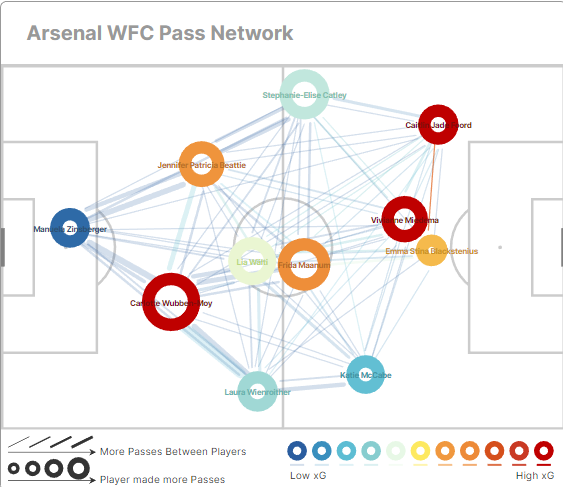When Arsenal lost Kim Little and Beth Mead to injury in quick succession, they didn’t just lose two important players, they lost two players who a) top the minutes played ranking for each of the last four seasons and b) who play next to one another. Little is the right-sided central-midfielder and Beth Mead the right-winger.
Add to that that the right centre-half, Leah Williamson, has also been injured and, if you want to stretch the example, Laura Wienroither has taken over from Noelle Maritz as the first-choice right-back, you can see it’s a lot of change in a short space of time. When he spoke to Arseblog News after the game, Jonas Eidevall said his team were rebuilding some key relationships.
“I think it is interesting what you say about relationships on the pitch because that’s what you lose when players are injured, you don’t only lose quality, you lose the relationships between different positions and you have to build again and that is what we are doing at the moment.” Here are some of the issues Arsenal came up against in the Everton match that demonstrate some lost fluidity, even if the team put up an XG of 3.3 and ought to have won this game more comfortably.

McCabe has played on the right for Arsenal to devastating effect before, most notably during Arsenal’s title-winning season. Since Jonas Eidevall arrived, Beth Mead has had that right-sided spot on lockdown. Obviously, McCabe, as a left-footer, will play the role differently to Mead as a more inverted winger. Here, Wienroither receives the ball from Wubben-Moy and we can see McCabe in the half-space we are used to seeing Mead operate in.

But because McCabe is left-footed, she wants the ball to feet here so she can chop inside on her left foot. Wienroither plays the ball in-behind, which Mead would have wanted. Neither player is incorrect here, it’s a simple misunderstanding based on muscle memory.

It’s similar in this scenario a few seconds later. Blackstenius holds the ball up on the edge of the area. She is used to Mead, a right-footer, making a run in behind the left-back here. McCabe’s left-footedness means she wants to hang back and get the ball into feet so she can cut in. Again, she isn’t wrong for doing that, it’s just that Blackstenius cannot have played many games for Arsenal where it wasn’t Mead outside her on the right, she is used to Mead’s movements.

Blackstenius hesitates because her muscle memory is telling her to expect Mead to run in behind and, in that half-second’s hesitation, she loses possession.

Arsenal had some issues playing out on their right-side in the first half too. Here Wubben-Moy rolls the ball back to Zinsberger, as is very normal.

Zinsberger is well closed down by the Everton front line but on Arsenal’s right-side, nobody is in the shot as Zinsberger looks to play to that side, which means the spacing isn’t quite right, there are too many players on the touchline.

Stenevik easily gobbles up the clearance and, again, you can just about see McCabe at the bottom of the screen but Wienroither and Wubben-Moy are not. Again, nobody is guilty of an egregious error here, it’s just a slight spacing error borne of unfamiliarity.

It leads to Everton’s best chance of the game but Wubben-Moy does brilliantly to recover and blocks Jess Park’s shot.

From the resulting goal kick, we see Wubben-Moy and Walti in conversation, potentially just sorting out some positional tweaks.

As Arsenal shape up for that goal kick, we see Walti moving over to the right, presumably the conversation was about Wubben-Moy holding a more central position in case Arsenal were exposed in transition, with Walti providing a connecting line to Arsenal’s right-hand side. On this occasion, Zinsberger plays the ball to the left in any case. It’s just an example of players having to sort some issues in-game that, with more games together in those specific positions, they would already know through muscle memory.

Here we see Wubben-Moy misplace a pass to McCabe.

A routine possession error most likely as the ball is played behind McCabe.

In the aftermath, we see McCabe signalling to Wienroither that she was expecting Laura to be in that position so that McCabe could push on. Again, no player is wildly in the wrong here, it’s just a case of learning to understand one another’s movements in real time.

But what starts to happen is that the players on the right begin to develop that muscle memory. McCabe is less likely to run in behind as a left-footer on the right, she is going to want to get on the ball and that makes her more of a playmaker. Soon enough the players start to subconsciously absorb this. Here Wienroither passes confidently into Miedema from right-back.

Miedema protects the ball and comes back to Walti and she immediately looks for Blackstenius in the right channel.

You can see where McCabe is as Walti looks for Blackstenius, she wants to come in off that flank onto her left foot, that means she is more of a wide playmaker. That being the case, she will come short for the ball and when players do that, they can attract defenders to them, thus leaving space in behind. That’s what happens here, George follows McCabe inside which gives Blackstenius space to hit the channel. Unfortunately, the pass hits the back of her heel.

A minute later, we see a far more fluid interchange. McCabe is in-field, as you would expect from an inverted winger. Wienroither has no hesitation in the pass.

McCabe touches the ball back to Walti and look at Blackstenius’ position.

Walti tries to hit the right channel. The pass is overhit but we have seen the exact same pattern from Arsenal twice in a minute on this side. Wienroither has fully assimilated that McCabe will want to show for the ball on her left foot. Miedema has understood that McCabe wants to drift into playmaking areas, so she has decided to let her do that and to behave more like a forward. By drifting into these areas, McCabe will take a defender with her and that creates space for Miedema to run into. It’s not a big coincidence that Miedema scores two minutes later, she has understood that McCabe will naturally find those spaces between the lines rather than running behind the full-back, so Miedema decides to start making more runs in behind the Everton defence to stretch them.
The footwork from Viv is just 🤯#BarclaysWSL @ArsenalWFCpic.twitter.com/dVC4utJuod
— Barclays Women's Super League (@BarclaysWSL) December 3, 2022
And when you look at the winning goal, it’s built on the right. Wienroither doesn’t hesitate in playing the ball in-field and whips a quick cross-field ball into the area for Foord and Miedema is on hand to do her thing in the area. That’s three times in the space of two minutes where Arsenal have started attacks by Wienroither passing in-field, whereas had Mead been playing she might ordinarily have expected to veer more towards the touchline.

The ball makes its way back to Wubben-Moy here. The screencaps don’t do it justice but the ball moves faster. Wubben-Moy is happy to go in-field to Walti here because she knows that McCabe will be in-field too.

Again, McCabe comes short to the ball off the flank. She isn’t going to run in behind, she wants the ball on her left foot.

There’s no hesitance from Walti, who just bumps the ball off to McCabe and she switches the play to Foord on the left. There’s less hesitance now, the players expect to go in-field on this side.

Here, Wubben-Moy dribbles the ball out of right centre-half. McCabe comes short again and Wubben-Moy is not surprised to see this but she is already looking at spreading the ball over to the left. Nothing earth shattering is happening here, it’s just that the right-side is getting used to McCabe’s movements on the right as opposed to Mead’s.

This pass map, courtesy of Statsbomb, shows you the pass network and you can see that McCabe is more connected to the midfielders than the forwards because her tendency as an inverted winger is to show for the ball rather than to run in behind.

This is Arsenal’s pass map from the previous game at Meadow Park, against West Ham- a reasonably comparable opponent and we see that Mead is more connected to the forwards.
In this game, Vivianne Miedema showed her intelligence to adapt to in-game situations, she started pushing on once she realised that McCabe would take up the playmaking areas between the lines. Miedema ended the game with seven shots, six of which were on target. The first of those was her goal on 24 minutes, that shows you that she adapted to the in-game situation. Arsenal had some small misunderstandings on the right which they sorted after 20 minutes or so.




Let’s hope they read this and learn from it…
Excellent analysis as usual Tim, good to see some understanding of the team dynamics as a whole and not the usual “xyz played bad” from some pundits.
Love that the players are able to adjust so quickly but cant but feel like this highlights the need for a “natural” winger. We don’t seem to be able to use the space on the right much which may hurt us against better teams who may kill the attack by clogging up the left side of the field. Maybe we have Catley stay in field more and shift the defense to cover the right half-space when attacking and have Wienthroter provide width moving higher up the pitch. Like Argentina do with acuńa or something of the sort
Jonas has been very clear that he’ll bring a player in in that position in January.
Did you realize, Gaby George was without pressure and cover more defending area, she blocked Stina, also Miedema and even Foord advances, sometimes she went very up-front in counterattack.